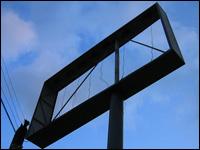Transcript
BOB GARFIELD:
On January 1st, 2007, a funny thing happened in Sao Paulo, Brazil. The city of approximately eleven million people, South America's largest, awoke to find a ban on public advertising. Every billboard, every neon sign, every bus kiosk ad and even the Goodyear blimp were suddenly illegal.
The ban on what the mayor calls "visual pollution" was the culmination of a long battle between the city's politicians and the advertising industry, which had blanketed Brazil's economic capital with all manner of billboards, both legal and illegal. Within months, the city has gone from a Blade Runner-like vision of the future to a reclaimed past.
Vinicius Galvao is reporter for Folha de Sao Paulo, Brazil's largest newspaper, and he joins us now. Vinicius, welcome to the show.
VINICIUS GALVAO:
Oh, thank you. I appreciate it. It's my pleasure.
BOB GARFIELD:
I've seen photos of the city, and it's amazing to see this sprawling metropolis completely devoid of signage, completely devoid of logos and bright lights and so forth. What did Sao Paulo look like up until the ban took place?
VINICIUS GALVAO:
Sao Paulo's a very vertical city. That makes it very frenetic. You couldn't even realize the architecture of the old buildings, because all the buildings, all the houses were just covered with billboards and logos and propaganda. And there was no criteria.
And now it's amazing. They uncovered a lot of problems the city had that we never realized. For example, there are some favelas, which are the shantytowns. I wrote a big story in my newspaper today that in a lot of parts of the city we never realized there was a big shantytown. People were shocked because they never saw that before, just because there were a lot of billboards covering the area.
BOB GARFIELD:
No writer could have [LAUGHING] come up with a more vivid metaphor. What else has been discovered as the scales have fallen off of the city's eyes?
VINICIUS GALVAO:
Sao Paulo's just like New York. It's a very international city. We have the Japanese neighborhood, we have the Korean neighborhood, we have the Italian neighborhood and in the Korean neighborhood, they have a lot of small manufacturers, these Korean businessmen. They hire illegal labor from Bolivian immigrants.
And there was a lot of billboards in front of these manufacturers' shops. And when they uncovered, we could see through the window a lot of Bolivian people like sleeping and working at the same place. They earn money, just enough for food. So it's a lot of social problem that was uncovered where the city was shocked at this news.
BOB GARFIELD:
I want to ask you about the cultural life of the city, because, like them or not, billboards and logos and bright lights create some of the vibrancy that a city has to offer. Isn't it weird walking through the streets with all of those images just absent?
VINICIUS GALVAO:
No. It's weird, because you get lost, so you don't have any references any more. That's what I realized as a citizen. My reference was a big Panasonic billboard. But now my reference is art deco building that was covered through this Panasonic. So you start getting new references in the city. The city's got now new language, a new identity.
BOB GARFIELD:
Well, cleaning up the city's all well and good, but how do businesses announce to the public that they're open for business?
VINICIUS GALVAO:
That was the first response the shop owners found for this law, because the law bans billboards and also even the windows should be clean. Big banks, like Citibank, and big stores, like Dolce and Gabbana, they started painting themselves with very strong colors, like yellow, red, deep blue, and creating like visual patterns to associate the brand to that pattern or to that color.
For example, Citibank's color is blue. They're painting the building in very strong blue so people can see that from far away and they can make an association with that deep blue and Citibank.
BOB GARFIELD:
Now, the city has said, having undertaken this effort, it will eventually create zones where some outdoor advertising will be permitted. Do you expect Sao Paulo eventually to just revert to its previous clutter?
VINICIUS GALVAO:
Not to revert to previous clutter, but I think like very specific zones, I think they're going to isolate the electronic billboards in those areas, in the financial center. I don't think they should put those in residential areas as we had before.
BOB GARFIELD:
Now, the advertising industry is obviously not happy about this. They're complaining that they're deprived of free speech and that it's costing them jobs and revenue. But is there anyone else in Sao Paulo who's unhappy about this? Tell me about the public at large. What's their view?
VINICIUS GALVAO:
It's amazing, because people on the streets are strongly supporting that. The owner of the buildings, even if they have to renovate a building, they're strongly supporting that. It's a massive campaign to improve the city. The advertisers, they complain, but they’re agreeing with the ban. What they say is that we should have created criteria for that to organize the chaos.
BOB GARFIELD:
Vinicius, thank you very much for joining us.
VINICIUS GALVAO:
Thank you so much.
BOB GARFIELD:
Vinicius Galvao is a reporter for Folha de Sao Paulo.

